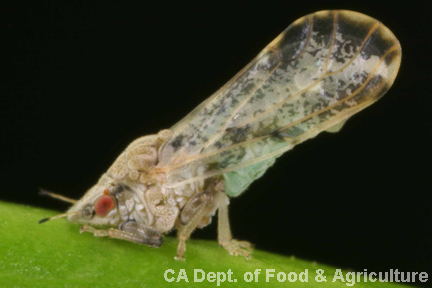
After several years of wary anticipation, the dreaded citrus greening disease, huanglongbing (HLB), has been found in southern California. And that has put officials in Santa Barbara County — and throughout the state — on high alert.
The devastating disease was detected in Florida in 2005, and has wiped out $1.3 billion in citrus revenue there. Since then, HLB has marched across a number of southern states, leaving thousands of dead trees in its wake.
HLB is carried by the Asian citrus psyllid. Occasional psyllids have been found in back yard gardens and commercial groves in California over the past few years. I first wrote about the threat in September 2009 (see below). Since then, the closest to Santa Barbara County that psyllids have been found has been in La Conchita and Santa Paula.
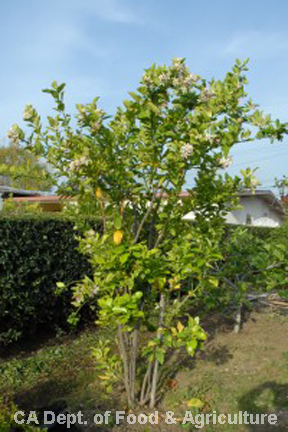
Not all Asian citrus psyllids transmit the disease, and up to this point, none proved to be a carrier.
But the infected lemon/pummelo tree found in Hacienda Heights is a real game changer.
It’s the first citrus tree to test positive for HLB in California. Psyllids found in the same neighborhood tested positive for the disease as well.
The tree has since been dug out and moved to a state lab for further testing.
State agriculture officials say they plan to “conduct treatment of citrus trees within 800 meters of the find site,” although what that treatment will be has not yet been revealed.
What is known is that there’s still no cure for the deadly disease.
What’s Next?
Locally, Santa Barbara County agriculture officials hope to prevent HLB from infecting Central Coast citrus trees through a quarantine, inspections and help from the public.
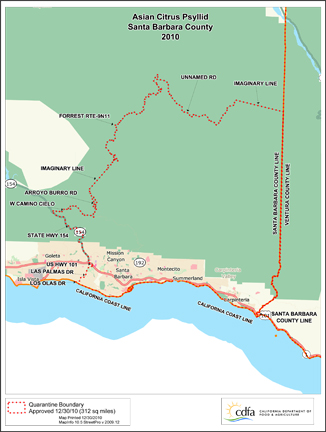
For now, a quarantine put into place in December 2010 is still in effect for southern Santa Barbara County.
The area runs from the Ventura County line to Highway 154, and from the coastline high into the foothills. It includes Summerland, Carpinteria, Santa Barbara, eastern Goleta and Painted Cave. No citrus of any type — no plants, clippings, leaves or fruit — is to be transported out of the quarantine area.
Strictly speaking, this means that if you live within the quarantine area and work in the western end of Goleta, you shouldn’t even pack a home-grown orange in your lunch.
The state has set up similar quarantines in Ventura, Imperial, Los Angeles, Orange, Riverside, San Bernardino and San Diego Counties.
What to Look For
Asian citrus psyllids are tiny, winged insects that feed with their heads down and their bottoms angled up at about 45 degrees.
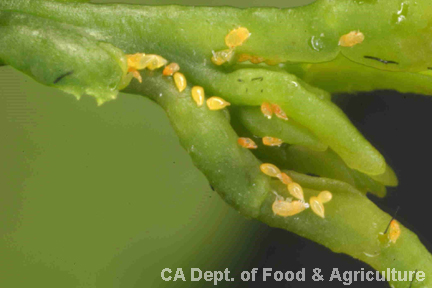
They produce tiny, bright, golden-yellow eggs, while the nymphs are dull orange and nearly impossible to see with the naked eye.
The damage that they cause is far more evident: yellow blotches on the leaves and misshapen, not-too-tasty fruit. Indeed, the Hacienda Heights tree had those yellow mottled leaves.
The trouble is, other diseases can cause similar symptoms.
If you suspect something is wrong with any of your citrus trees, take a sample to the county agriculture commissioner’s office. Instructions are listed below.
Here’s what I wrote back in September 2009. Dramatic then, perhaps, but even more so today.
Imagine a day with no fresh-squeezed orange juice. No lemon zest. No slices of lime. No sweet Satsuma tangerines. No citrus of any kind.
That’s a doomsday that California agricultural officials are trying to prevent. And they’re looking for help from everyone who grows citrus trees — from a singe lemon planted in a pot on a patio, to the largest commercial groves in the state.
All citrus — oranges, lemons, limes, grapefruits, mandarins, tangerines, tangelos, kumquats, citrons, pomelos and the like — are at risk, as well as closely related ornamental plants, such as orange jasmine (Murraya paniculata), cape chestnut trees (Calodendrum capensis) and culinary curry leaves (Murraya koenigii), which may be shipped in from Hawaii or India.
The Threat
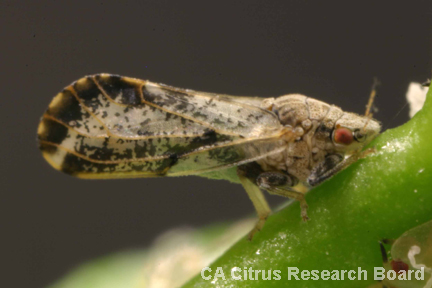
The threat starts with the Asian citrus psyllid. On their own, the tiny insects don’t cause irreparable damage.
But they deal a lethal blow to citrus trees when they become infected with Huanglongbing (HLB), a devastating bacterial plant disease that’s also known as citrus greening disease.
Essentially, the disease deforms the fruit and makes it tastes bitter, then kills the tree.
There is no cure.
“The combination of the Asian citrus psyllid and the disease has the greatest potential to impact citrus growing in California of anything I’ve ever seen,” said Bill Gillette, Santa Barbara County Agricultural Commissioner. “The reason for that is that the Mediterranean fruit flies, the other fruit flies, we can get rid of. This one, they haven’t been able to stop it anyplace yet, and it actually kills the trees.”
The deadly duo has ravaged groves around the world, including Asia, India, Egypt, Africa and Brazil. The disease was discovered in Florida in September 2005, and has since spread throughout the state, taking a serious bite out of Florida’s $9.3 billion juice industry. HLB has also been detected in South Carolina, Georgia, Louisiana, Belize and the Yucatan Peninsula.
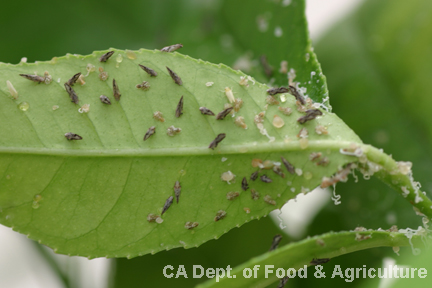
Meanwhile, the psyllids — not yet carrying HLB, as far as anyone knows — are moving into California. They were first reported in groves in San Diego and Imperial Counties in August 2008. Last week, they showed up in Santa Ana on a lemon tree, and in Echo Park on a calamondin tree, which bears small, tangy orange fruit. Quarantines are in effect everywhere the psyllids have been found, including all 800 square miles of Orange County.
A serendipitous finding of the dreaded Huanglongbing occurred in July — although not on a live tree. Instead, an agricultural inspection “sniff dog” at a FedEx facility in Fresno found a duffle bag shipped from India that carried curry leaves and infected psyllids.
Another sniff dog, this one last week at a FedEx depot in Sacramento, detected psyllids inside a package from Texas containing guavas and curry leaves. Fortunately, none of those psyllids tested positive.
“No one can say for sure if the disease will ever get here (to Santa Barbara County),” said Gillette. “One, you hope it doesn’t, but it’s likely it will. Then two, you hope it isn’t going to have the same effect on citrus in this area. But I think that’s pretty naive.”
The Symptoms
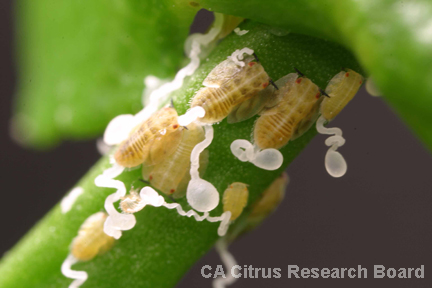
At 3 to 4 millimeters in length at maturity, Asian citrus psyllids are so tiny, even the experts can have trouble detecting them.
“When I spoke with the entomologist in San Diego County, he said they were really hard to see,” said Brian Cabrera, Santa Barbara County Entomologist.
“Several people, all experts, were looking for the insects. They all looked but couldn’t find them. Then they vacuumed the leaves, and they actually found the psyllid that way.”
So rather than searching for psyllids, Cabrera said, homeowners should look for their damage. Asian citrus psyllids feed on new stems and leaves. That’s why agricultural officials are on high alert now, since citrus trees push out new growth between late summer and early winter.
Psyllids that aren’t infected with greening disease can still harm leaves, Cabrera said. “Their saliva actually has some toxicity to cause the leaves to curl. (And) they produce a tiny amount of wax.”
But the damage is far worse once the disease strikes.
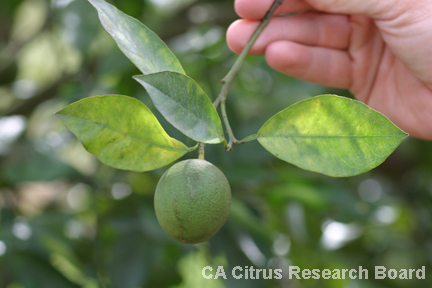
“Homeowners should look for anything suspicious with their trees, any sudden decline in the trees, any abnormalities, or yellowing of the leaves,” Cabrera said. “The fruit is abnormal, lopsided and bitter. The leaves have a twisted, gnarled, deformed look.”
Also, according to the California Citrus Research Board, “As HLB progresses, leaves and whole branches fall off the tree and eventually the entire tree dies.”
Unfortunately, identification is tricky because plenty of other pests, diseases and mineral deficiencies create the same symptoms. For instance, chlorosis, a common iron deficiency in citrus, also causes yellowing leaves.
“The main problem is that the symptoms are not diagnostic,” said Heather Scheck, Santa Barbara County Plant Pathologist. She sends questionable leaves to a lab in Sacramento for molecular testing. “It could also be a nutritional problem. It could be another disease, viral, bacterial or fungal. That’s what happened in Florida. They probably had it in for a long time. It wasn’t until they did the actual testing that they discovered they had citrus greening disease.”
What to Do
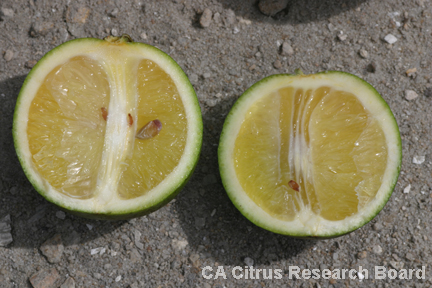
County agricultural officials urge anyone who suspects that their plants are being harmed by any type of insects or disease, not just Asian citrus psyllids or citrus greening, to collect samples for testing. The service is free.
“One of our missions is to reduce pesticide use. We accomplish that by giving accurate diagnosis,” Scheck said. “You don’t want to hear that someone has sprayed and sprayed, only to discover that it’s a virus or nutritional thing.”
Insect samples should include both the insects and a few damaged leaves, while suspicious stems and leaves should be on branches at least 18 inches long.
Two of the agricultural commissioner’s offices accept walk-ins between 8 a.m. and 4:30 p.m., Monday through Friday: 624 W. Foster Rd., Santa Maria, 934-6200; and 263 Camino del Remedio, Santa Barbara, 681-5600. Or make an appointment to leave samples at 121 N. G St., Lompoc, 737-7733; or 1745 Mission Dr., Solvang, 686-5064.
In addition, the California Department of Food and Agriculture (CDFA) has added the Asian citrus psyllid to its residential trapping program, which is how the psyllids were discovered in Santa Ana and Echo Park. Here in Santa Barbara County, CDFA technicians based in Buellton set traps in neighborhoods, parks and business centers countywide.
“Non-indigenous fruit flies are our main deal. Mediterranean, Mexican, Oriental and melon flies. We also do the light brown apple moth, Asian citrus psyllid and false coddling moth. That’s what we’re trapping for now,” said Jay Burwell, a CDFA Agricultural Technician III. “Right now, we have 368 locations. But that fluctuates highly for seasonal host availability.”
Yellow sticky cards are the trap of choice for the Asian citrus psyllid, which Burwell’s office sends to Sacramento for testing and identification.
“The problem is, there are so many psyllids,” he said. “If there were only one type of psyllid, it would be easy to detect.”
≈
Stop the Transport
Because there is no cure for Huanglongbing (HLB) or citrus greening disease, the only way to prevent the deadly disease is to avoid transporting citrus trees, citrus fruit and closely related plants, such as orange jasmine, cape chestnut trees and curry leaves.
According to the US Department of Agriculture, “The safest approach is simply to not move citrus plants, ship citrus plants, or buy host citrus plants online unless you are absolutely sure the plant is not from an area that is quarantined for either citrus greening disease or Asian citrus psyllids.”
Santa Barbara County Agriculture Commissioner Bill Gillette echoes those thoughts.
“The message for everybody isn’t so much this particular insect as it is for all fruits and vegetables, whether you’re dealing with Oriental fruit flies or the light brown apple moth or Asian citrus psyllids. Those generally don’t get here by themselves,” he said.
“These types of things, certainly the disease, that’s how it’s going to get in here. Somebody’s going to either inadvertently or smuggle some infected plant material in here. Then we’ve got a problem.”
≈
Useful Websites
To learn more about the Asian citrus psyllid and Huanglongbing (HLB) or citrus greening disease, read prevention tips, and view photos of the psyllid and the damage it can cause, visit:
The Citrus Research Board
californiacitrusthreat.com
California Department of Food & Agriculture
cdfa.ca.gov/phpps/acp/
UC Agriculture and Natural Resources
http://ucanr.org/sites/KACCitrusEntomology/Home/Asian_Citrus_Psyllid/
US Department of Agriculture
saveourcitrus.org
≈
Seeds of Wisdom
If you suspect any problem with your citrus trees, especially on new growth, take a sample to an office of the county agricultural commissioner for a diagnosis or call the state pest hotline, (800) 491-1899.
≈
Copyright, Joan S. Bolton. All rights reserved. Reproduction of text or photos in any form is prohibited without written permission.
≈
